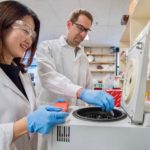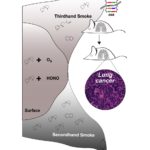Genome-wide association (GWAS) and familial studies have found mutations that disrupt the function of KDM5 proteins in patients with autism spectrum disorders and related intellectual disabilities. Biological Systems and Engineering (BSE) Division researchers Jian-Hua Mao, Antoine Snijders, and Susan Celniker, in collaboration with a team of scientists led by Xingyin Liu at Nanjing Medical University (NMU) in China, used genetic tools in Drosophila to delineate how KDM5 contributes to autism and intellectual disability.
A New Mouse Model for Studying Stomach Cancer
An international team led by researchers in Berkeley Lab’s Biosciences Area has identified a new laboratory mouse strain for studying gastric cancer. The mouse lineage is part of a population called the Collaborative Cross (CC) mouse model that was bred to have greater genetic diversity than previous populations, so as to be more comparable with humans. The team monitored hundreds of mice from different CC strains for one year and observed that one line spontaneously developed tumors—stomach and lymphoid being the most prevalent types—at an extremely high rate. Subsequent genetic analysis of the tumors in this cancer-prone line revealed that an inflammatory response regulating a protein called Nfκb1 could be a key driver of cancer susceptibility in this mouse model.
Read more in the Berkeley Lab News Center.
Biosciences Area FY19 LDRD Projects
The projects of 13 Biosciences Area scientists and engineers received funding through the FY19 Laboratory Directed Research and Development (LDRD) program. The funded projects span a diverse array of topics and approaches including the harnessing of microbiome data to uncover patterns of mutualism, evaluating radiobiological effects of laser-accelerated ion beams, improving bioenergy yield under drought stress, and the application of machine learning in tomogram segmentation. Lab-wide, 89 projects were selected from a field of 158 proposals. Biosciences Area efforts account for 15.07 percent of the $22.2 million allocated.
Thirdhand Smoke Found to Increase Lung Cancer Risk in Mice
Cigarette smoke contains myriad compounds that are known mutagens and carcinogens, and the health risks associated with active smoking and secondhand smoke are well established. Nearly 10 years ago, researchers at Berkeley Lab identified another potentially hazardous source of tobacco exposure: “thirdhand smoke,” the toxic residues that linger on indoor surfaces and in dust long after a cigarette has been extinguished. A team led by Antoine Snijders, Jian-Hua Mao, and Bo Hang in Biosciences’ Biological Systems and Engineering (BSE) Division have determined that early thirdhand smoke exposure is also associated with increased incidence and severity of lung cancer in mice.
Thirdhand Smoke Study Gets Renewed Media Attention
Research published earlier this year by Berkeley Lab scientists in Biological Systems and Engineering Division (BSE) showing that exposure to thirdhand smoke was associated with low body weight and immune changes in young mice has recently received a flurry of renewed media attention. Antoine Snijders was interviewed via Skype for a segment that aired on New York’s Fox 5 News. In it, he noted that human infants and toddlers could potentially be at risk of exposure. “They play with toys, they play on carpets, there’s much more hand-to-mouth action than most adults do. So the exposure levels could be significantly higher in that age group,” he said. An article on USAToday.com quoted Bo Hang and Jian-Hua Mao. “We suspected that the young are most vulnerable because of their immature immune systems, but we didn’t have a lot of hard evidence to show that before,” Hang said. The study was also referenced on the blog Bustle which linked to the original Berkeley Lab News Center article.
- « Previous Page
- 1
- …
- 3
- 4
- 5
- 6
- 7
- Next Page »
Was this page useful?








